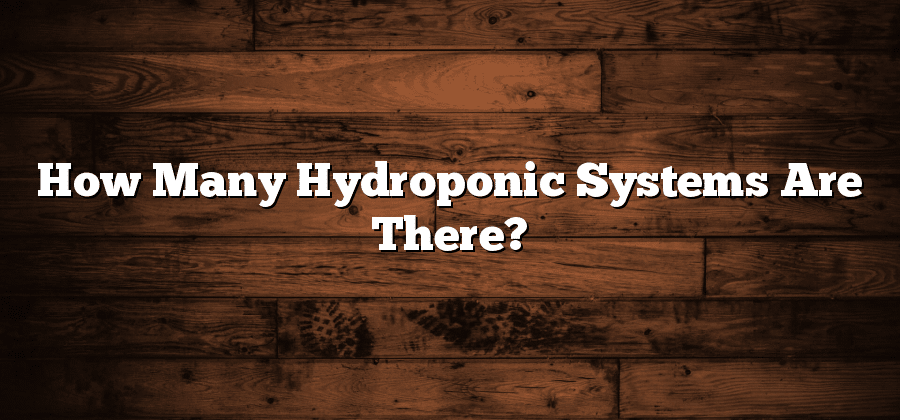Understanding the Different Types of Hydroponic Systems
Hydroponic systems are innovative methods of growing plants without the need for soil. They have gained significant popularity among gardeners and farmers due to their efficiency and ability to produce high yields in smaller spaces. Understanding the different types of hydroponic systems is crucial in choosing the right system for your needs.
One commonly used hydroponic system is the Deep Water Culture (DWC) system. In a DWC system, plants are suspended in a nutrient-rich solution, with their roots directly submerged in the water. This allows for efficient nutrient absorption, resulting in rapid plant growth. The simplicity of the DWC system makes it ideal for beginners or those with limited space. However, it requires continuous monitoring of water levels and nutrient concentrations to maintain optimal conditions for plant growth.
Exploring the Key Features of Each Hydroponic System
Deep Water Culture (DWC) is a popular hydroponic system known for its simplicity and effectiveness. In this system, plants are placed in net pots filled with an oxygenated nutrient solution. The net pots are suspended in a reservoir, allowing the roots to continuously access the nutrient solution. This promotes rapid growth and efficient nutrient uptake. One key feature of DWC is the use of airstones or diffusers to oxygenate the nutrient solution, ensuring the roots receive ample oxygen for optimal growth. Additionally, DWC systems are relatively easy to set up and maintain, making them suitable for beginners in hydroponics.
Another commonly used hydroponic system is the Nutrient Film Technique (NFT). Unlike DWC, NFT does not use a growing medium to support the plants. Instead, a thin film of nutrient solution flows continuously over the roots, providing them with nutrients and oxygen. The roots are exposed to the air, promoting increased oxygen absorption. This system relies on gravity to create a gentle flow of the nutrient solution along a sloping channel. The key feature of NFT is its efficient use of water and nutrients. With a constant recirculation of the solution, NFT minimizes wastage and allows for precise control over nutrient concentration, leading to optimal plant growth.
Examining the Pros and Cons of Various Hydroponic Systems
When it comes to hydroponic systems, each type has its own set of advantages and disadvantages. One popular option is the nutrient film technique (NFT) system. The NFT system allows for constant nutrient flow, ensuring that plants receive a consistent supply of water and essential nutrients. This system is known for its high production yields and efficient use of water and nutrients. However, it also requires careful maintenance, as any interruption in the flow of the nutrient film can lead to crop failure.
Another commonly used hydroponic system is the deep water culture (DWC) system. In this system, plants are suspended in a nutrient-rich solution, with their roots immersed in the water. The simplicity of the DWC system makes it ideal for beginners, as it requires minimal equipment and is relatively easy to set up. Additionally, the oxygen-rich environment promotes healthy root growth. However, as the plants are fully dependent on the nutrient solution, any disruption in the system can be detrimental to the plants, resulting in rapid decline and potential crop loss.
Choosing the Right Hydroponic System for Your Needs
When it comes to choosing the right hydroponic system for your needs, there are a few key factors to consider. First and foremost, you need to assess the space you have available. Different types of hydroponic systems require different amounts of space, so it’s important to choose one that fits within your constraints.
Next, think about the types of plants you want to grow. Certain hydroponic systems are better suited for specific plants, so it’s important to align your system choice with your desired crops. Consider factors such as nutrient requirements, lighting needs, and root support.
Another important consideration is your level of experience and expertise. Some hydroponic systems require more technical know-how and maintenance than others. If you’re new to hydroponics, it may be best to start with a simpler system before advancing to more complex setups.
Lastly, think about your budget. Hydroponic systems can vary greatly in price, so it’s important to set a budget and find a system that fits within it. Keep in mind that additional costs such as lighting, nutrients, and maintenance will also need to be factored in.
By carefully considering factors such as space, plant requirements, expertise level, and budget, you can choose the right hydroponic system that best suits your needs.
Factors to Consider When Selecting a Hydroponic System
There are several factors to consider when choosing a hydroponic system that best suits your needs. One important consideration is the size and space available for your hydroponic setup. If you have limited space, you may want to opt for a compact system, such as a vertical or countertop hydroponic system, that can maximize the use of limited space.
Another factor to consider is the type of plants you wish to grow. Different varieties of plants have different requirements in terms of nutrient levels, pH levels, and lighting. It is important to choose a hydroponic system that can be easily adjusted and customized to meet the specific needs of the plants you intend to grow.
Additionally, the level of automation and maintenance involved should also be taken into account. Some hydroponic systems require frequent monitoring and adjustment, while others are more automated and require less hands-on attention. Consider your time availability and comfort level with managing the system. Furthermore, the initial cost and long-term expenses of the system, such as electricity consumption and replacement parts, should also be factored in when making a decision.
In conclusion, selecting the right hydroponic system involves considering factors such as available space, plant requirements, level of automation and maintenance, as well as associated costs. By carefully evaluating these factors, you can ensure that you choose a hydroponic system that will effectively support the growth and health of your plants.






